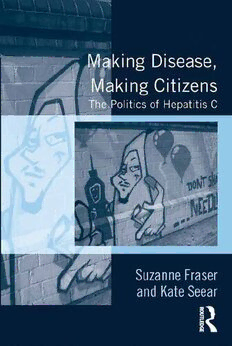
Making Disease, Making Citizens: The Politics of Hepatitis C PDF
Preview Making Disease, Making Citizens: The Politics of Hepatitis C
MAKING DISEASE, MAKING CITIZENS This page has been left blank intentionally Making Disease, Making Citizens The Politics of Hepatitis C SUZANNE FRASER AND KATE SEEAR Monash University, Australia First published 2011 by Ashgate Publishing Published 2016 by Routledge 2 Park Square, Milton Park, Abingdon, Oxon OX14 4RN 711 Third Avenue, New York, NY 10017, USA Routledge is an imprint of the Taylor & Francis Group, an informa business Copyright © Suzanne Fraser and Kate Seear 2011 Suzanne Fraser and Kate Seear have asserted their right under the Copyright, Designs and Patents Act, 1988, to be identified as the authors of this work. All rights reserved. No part of this book may be reprinted or reproduced or utilised in any form or by any electronic, mechanical, or other means, now known or hereafter invented, including photocopying and recording, or in any information storage or retrieval system, without permission in writing from the publishers. Notice: Product or corporate names may be trademarks or registered trademarks, and are used only for identification and explanation without intent to infringe. British Library Cataloguing in Publication Data Fraser, Suzanne, 1967- Making disease, making citizens : the politics of hepatitis C. 1. Hepatitis C--Social aspects. 2. Hepatitis C--Patients. 3. Hepatitis C--Treatment--Moral and ethical aspects. 4. Harm reduction. 5. Feminism and science. I. Title II. Seear, Kate. 362.1'963623-dc22 Library of Congress Cataloging-in-Publication Data Fraser, Suzanne, 1967- Making disease, making citizens : the politics of hepatitis C / by Suzanne Fraser and Kate Seear. p. cm. Includes index. ISBN 978-1-4094-0839-0 (hardback) 1. Hepatitis C--Social aspects. 2. Hepatitis C--Political aspects. I. Seear, Kate. II. Title. RC848.H425F73 2011 362.196'3623--dc23 2011027182 ISBN 9781409408390 (hbk) ISBN 9781315593296 (ebk) Contents List of Figures vii Acknowledgements ix Introduction: A Gathering 1 1 Towards a Quasispecies Epistemology 19 2 How Disease Holds Together: Hepatitis C and Health Promotion 41 3 Materialising Hepatitis C and Injecting Drug Use in Self-help Literature and Beyond 65 4 Knowing, Doing, Hoping: Diagnosis and the Limits of Biological Citizenship 83 5 From Centre to Periphery: The Ethics and Politics of Treatment 111 Conclusion: The ‘Smoldering and Fluctuating Course’ 141 Bibliography 149 Index 163 This page has been left blank intentionally List of Figures 2.1 ‘Bloody Little Fact Book’: Hepatitis C in health promotion 55 2.2 So very tired: Hepatitis C in health promotion 57 2.3 Watch yourself!: Hepatitis C in health promotion 58 This page has been left blank intentionally Acknowledgements This book is based on a research project funded by the Australian Research Council. The authors were based in the School of Political and Social Inquiry in the Faculty of Arts at Monash University, Melbourne, Australia. Suzanne Fraser’s research and writing was also undertaken during a period spent at the National Centre in HIV Social Research at the University of New South Wales, Australia. Suzanne is a visiting fellow at the NCHSR and gratefully acknowledges the hospitality and support she received during the six months she spent there. The chief investigators on the project from which the book emerges were Suzanne Fraser, Carla Treloar (based at the NCHSR) and David Moore (based at the National Drug Research Institute, Curtin University, Perth, Australia). We thank Carla and David for their contributions to the research project as a whole and for their valuable professional insights into drug use and hepatitis C. Importantly, the study was anchored in 30 in-depth interviews with people diagnosed with hepatitis C. We are extremely grateful to our interview participants for their generosity in agreeing to talk to us about their experiences. Recruiting these participants and conducting the interviews was a major task requiring detailed knowledge of the area, tact and perseverance, and we are indebted to Emily Lenton for undertaking this key part of the research. We are also indebted to Hepatitis Victoria for their invaluable assistance with recruitment. Emily also coordinated the collection of health promotion literature, medical journal articles and self-help books and, overall, made an invaluable contribution to the study through her impressive knowledge of the area and her unerring sensitivity and insight into the lives and experiences of people with hepatitis C. Of course, each of us also drew support and inspiration from different friends and colleagues. Accordingly, Suzanne would like to express her gratitude to the following people. My first debt of gratitude is owed to Kate Seear, whose skill, humour and energy made writing this book a pleasure. Kate is an exceptionally talented scholar able to bring to her work a rare mix of analytical acuity, creativity and pragmatism. She is also a great friend who has been very much missed since her move to the United Kingdom during the final stages of writing this book. For much appreciated companionship and advice at the NCHSR, I thank Carla Treloar, Max Hopwood, Asha Persson, Jeanne Ellard, Dean Murphy, Jake Rance and Joanne Bryant. I am also very grateful for the friendship and support offered by the following people: Robyn Dwyer, Celia Roberts, kylie valentine, Gina Thomson, Rebecca Winter, Mark Davis, Narelle Miragliotta, Steven Angelides, JaneMaree Maher and Jo Lindsay. For so many acts of kindness, care and
